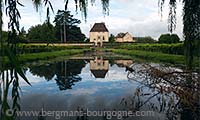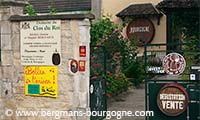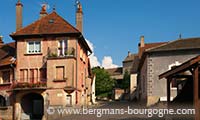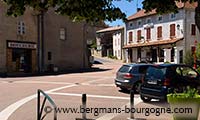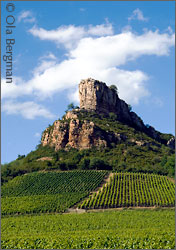
ith its 757 hectares Pouilly-Fuissé is one of Burgundy's largest village appellations. Only Chablis and Petit Chablis cover more land. As is the case with its cousins in the northwest of Burgundy this is purely about chardonnay. It's the four communes of Chaintré, Fuissé, Solutré-Pouilly and Vergisson that make up the appellation. Together they form a large band about ten kilometres west of Mâcon that runs from southeast to northwest.
Directly to the east are the two satellites of Pouilly-Vinzelles and Pouilly-Loché, two considerably smaller appellations. Pouilly-Vinzelles is 52,12 hectares and Pouilly-Loché 32,14 hectares. While there are some 6 657 000 bottles of Pouilly-Fuissé produced annually Pouilly-Vinzelles and Pouilly-Loché only produce 362 000 and 244 000 bottles respectively.
In the northern end of the appellation you'll find the two cliffs that have become the symbols for the Mâconnais area, the Roche de Solutré (492 m) and the Roche de Vergisson (485 m). The former gives shelter from the northwinds to Solutré-Pouilly and the latter to Vergisson.
As in many other places in Burgundy winegrowing has a long history here. Commercially, winegrowing began here in the 2nd century, during the Pax Romana when there was a long period of relative calm after the Roman invasion of the Gaul. Already in the 11th century two thirds of the land available for crops was under vines.
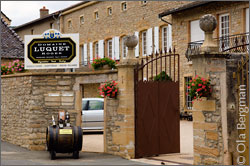
When André Jullien published his classification of the world's vineyards in 1866 – Topographie de Tous les Vignobles Connus – he wrote this about the wines from Pouilly: "The wines from this vignoble are much-valued and really deserve to be in the third class of the French wines". He placed the wines from Fuissé (spelt Fuissey at the time) in the same category. The wines from Chaintré (spelt Cheintré) and Solutré were placed one step down from their neighbours, while Vergisson, Vinzelles and Loché ended up another step further down.
This was long before the appellation system. With the appearance of the appellation Pouilly-Fuissé in 1936 the wine from all four communes became bottled under the same label. The use of putting the various lieux-dits on the labels is not particularly widespread.
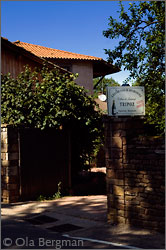
This may be about to change now. The winegrowers within the appellation have put together an application to the INAO – the Institut national de l'origine et de la qualité, the French organization charged with regulating French agricultural products with Protected Designations of Origin. Controlled by the French government, it forms part of the Ministry of Agriculture. It's a long process and it might still be a few years before we see any results.
The Pouilly-Vinzelles and Pouilly-Loché appellations followed a few years after the Pouilly-Fuissé. Pouilly-Loché wines may be bottled as Pouilly-Vinzelles, but not the other way around. The difference in character between the appellations is small. The Pouilly-Vinzelles and the Pouilly-Loché could be said to be slightly rounder than the Pouilly-Fuissé, but the winemaker's influence is probably of greater importance.
In Solutré, right opposite the main square, you will find the Atrium, a wine shop run by the Pouilly-Fuissé producers. You will have a large number of different Pouilly-Fuissés to choose from here. Pouilly-Fuissé rules here, so even if the producers in question have other appellation in their portfolio you will not find them here.
© 2013 Ola Bergman










